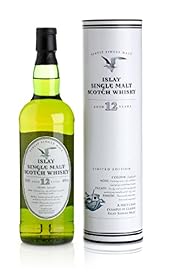 A
letter flopped down onto my doormat last week (probably - I didn’t actually see
it happen). It was the renewal notice for membership of the Scotch Malt Whisky
Society. Already my first 12 months are nearly up and this letter has caused me
to reflect on being a member of the society and whether I should renew for
another year.
A
letter flopped down onto my doormat last week (probably - I didn’t actually see
it happen). It was the renewal notice for membership of the Scotch Malt Whisky
Society. Already my first 12 months are nearly up and this letter has caused me
to reflect on being a member of the society and whether I should renew for
another year.
Where
to start. I don’t want to regurgitate the history and the ethos of the SMWS,
you can get all that from their website so I won't bother repeating it. In it's
most basic terms they are independent bottlers. They get single malt whisky
direct from distilleries, buying up individual casks and bottling them directly
at that strength (about 50-60%).
What’s
interesting is that they don’t name the distillery on the bottle,
instead relying only on a numbering system and tasting notes (plus the details of
the region, age and finish). I like this a lot. When you are looking to try a
dram or a buy a bottle it encourages you to try a whisky based on its
description (OK, and price), rather than looking for a familiar handle. Which is
just as well because often these whiskies can differ greatly from the
established 'taste' of a distillery (e.g. casks of unpeated Islay or unusual
finishes).
Of
course once you're actually drinking the stuff you can’t help but wonder
where it's from. And with smartphones and the internet being things that exist
you can find out what the distillery numbers mean right there and then. But
the crucial thing is that I like to find out afterwards. As such I’ve
tried some gems from distilleries I wouldn’t have thought of trying otherwise
(or even heard of) Glenburgie, Miltonduff, Benrinnies. I've never had a
bad whisky from SMWS and there is always something new to taste because the
bottles don't stick around too long (a cask might only provide 200 bottles).
A
quick word on the descriptions. All the whiskies go by a number and a
description, these are quite esoteric ('BBQ on the Beach', 'Magic Carpet Ride'
- that sort of thing) – they're quite amusing, although personally I find it becomes a
borderline cutesy after a while. Not that I’d want to see that changed, it's fair
enough - that's their thing. Even if they are a bit 'wacky' they're preferable to dry tasting notes or – god
forbid - a score.
But
generally I love their approach to whisky. It is there to be drunk. That might sounds
obvious but there are no special edition bottlings or presentation cases here.
Bottles that might cost £60 look exactly the same as those at £300. And although they turn up some rarities or unusual casks the
emphasis is always on enjoying them. I find that helps to get over the mental
hurdle of holding on to whisky too long because it's too special or precious to
be drunk. And when there are so few bottles in the first place there’s almost no point
getting too precious about it.
So
that's the whisky but I have to talk about the tasting rooms. I think that’s
the main value I get out of being a member. I’m lucky enough to live in
Edinburgh and there are two venues here. One on Queen St. near the city centre.
It's nice, spread over several floors in a traditional grand Edinburgh building.
It has great views into Queen St gardens, down towards the shore and over the
Firth of Forth and into Fife.
But
it’s the Vaults down in Leith that truly wins out. It’s this venue that makes
it feel like a club. It has wood-panelling, leather sofas and chairs, open
fires (well, convincing gas versions). It feels… exclusive, but thankfully
neither the venue or the staff take itself too seriously so you can enjoy the
rarefied surroundings without it feeling at all stuffy. This is a wonderful
place to bring friends and family. Nice and lively on a weekend, serenely
peaceful at other times. Visiting either of the venues adds a little joy to any
day. Either popping into George St on a Saturday afternoon to avoid the
shoppers. Or topping and tailing a night in one of Leith's many fine
restaurants with a visit to the Vaults.
So
what are the drawbacks? Well, there's the cost. There’s no getting away the
fact that this is a luxury. The initial joining fee was relatively steep – over
£100. This comes with a 4x10cl bottle taster pack plus some other knick-knacks.
I have to say this fiduciary blow was soften immensely by a ‘free’ bottle on
offer for new members, but I don’t know how often such promotions are run.
Of
the 4 taster bottles there was a great selection. One of the bottles was an
amazing 20yo Rosebank – old and rare so that had to be worth a few quid. And
tasting it was something that has prompted me to find out more about this
defunct distillery and other lowland whiskies in general. It was one of the
finest whiskies I've had and it came out of nowhere in terms of where my
interests lay. A new discovery which is what the SMWS is all about really.
I
still don’t know whether it’s a cost effective way to buy whisky. You’ll
struggle to find a bottle for less than £50. Most seem to be £50-70 with no
upper limit. It puts me off picking up a bottle for casual supping. But then
again it is single cask which tends to be more expensive even when it’s a
distillery bottling. But you could also argue that the extra cost is the
expertise required to taste and track down the whisky in the first place.
The
venues aren’t too cheap either - most of the dram prices are about £5 and going
up to £25. Everything else (wine, beer, food) is slightly uplifted from normal
pub prices. So there's that.
Another
drawback - much as I’ve espoused the virtues I’ve still only made it to the
venues 7 or 8 times in 12 months. Other friends that are members regularly
lament the fact that they don't get down to the venues more often. Which isn't a
reflection on the SMWS but it just illustrates the fact that it often feels
like a luxury.
But,
as I look again at the renewal notice (well not literally, it's in the other room) I
can't help but think I have to renew. I'm still in the thrall of the SMWS, I
still love the venues, I still love trying the whiskies, I love the quarterly
magazine, I get excited even just reading the monthly outturn offers - even when
I know I won't be buying bottle this month.
So, I’ll
will be renewing once more.
Update in 12 months time.
